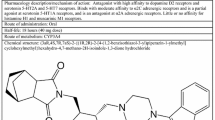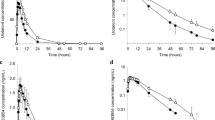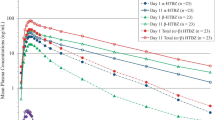Summary
Haloperidol (HAL) is a potent butyrophenone antipsychotic agent which is reversibly metabolized to reduced haloperidol (RHAL). In order to determine if this reversible metabolic pathway is linked to the debrisoquine 4-hydroxylase isozyme of cytochrome P-450 (P450IID6), HAL (5 mg) or RHAL (5 mg) was orally administered to healthy male volunteers in a randomized crossover design both with and without a prior (1 h) oral dose of quinidine (250 mg bisulfate), a potent inhibitor of this isozyme. Thirteen volunteers, 11 extensive metabolizers, 2 poor metabolizers, completed all four phases of the study. Plasma samples harvested over seven days were analysed for HAL and RHAL. An expression for the apparent fractional availability of metabolite from the parent compound given (Fapp suppinfm ) was derived and was used to determine whether HAL or RHAL is the preferred metabolite, and whether quinidine co-administration alters Fapp for either compound.
The AUC (0-t) for both HAL and RHAL were significantly greater following the administration of either compound with quinidine compared with AUC (0-t) values obtained in the absence of quinidine. The maximum plasma concentration (Cmax) of the administered compound was also greater following the administration of quinidine. Quinidine had no effect on the half-lives of the administered compounds. The Fapp for HAL and RHAL were not significantly affected by the administration of quinidine, indicating that the interconversion of HAL and RHAL is not linked to P450IID6. The Fapp of RHAL after administration of HAL was significantly greater than the Fapp of HAL after RHAL administration, indicating that RHAL is the preferred metabolic form. This difference was not affected by quinidine.
It is concluded that: 1) RHAL is the preferred form after administration of either compound and is not affected by quinidine, 2) the interconversion of HAL and RHAL is not affected by quinidine, indicating that this reversible metabolic process is not linked to P450IID6 and 3) there is a significant increase in the AUC (0-t) and Cmax values following quinidine co-administration with either HAL or RHAL. The precise mechanism of this interaction can not be established from this study, however, the observed increases in AUC (0-t) and Cmax may be explained with a simple tissue blinding displacement mechanism.
Similar content being viewed by others
References
Forsman A, Folsch G, Larsson M, Ohman R (1977) On the metabolism of haloperidol in man. Curr Therap Res 21: 606–617
Forsman A, Larsson M (1978) Metabolism of haloperidol. Curr Therap Res 24: 567–568
Pape BE (1981) Isolation and identification of a metabolite of haloperidol. J Anal Toxicol 5: 113–117
Oida T, Terauchi Y, Yoshida K, Kagemoto A, Sekine Y (1989) Use of antisera in the isolation of human specific conjugates of haloperidol. Xenobiotica 19: 781–793
Korpi JR, Wyatt RJ (1984) Reduced haloperidol: effects on striatal dopamine metabolism and conversion to haloperidol in the rat. Psychopharmacologia (Berl) 83: 34–37
Ereshefski L, Davis CM, Harrington CA, Jann MW, Browning JL, Saklad SR, Burch NR (1984) Haloperidol and reduced haloperidol plasma levels in selected schizophrenic patients. J Clin Psychopharmacol 4: 138–142
Altamura AC, Mauri MC, Cavallaro R, Gorni A (1987) Haloperidol metabolism and antipsychotic effect in schizophrenia. The Lancet I: 814–815
Inaba T, Kovacs J (1989) Haloperidol reductase in human and guinea-pig livers. Drug Metab Dispos 17: 330–333
Inaba T, Kalow W, Someya T, Takahashi S, Cheung SW, Tang SW (1989) Haloperidol reduction can be assayed in human red blood cells. Can J Physiol Pharmacol 67: 1468–1469
Midha KK, Hawes EM, Hubbard JW, Korchinski ED, McKay G (1987) Interconversion between haloperidol and reduced haloperidol in humans. J Clin Psychopharmacol 7: 363–364
Chakraborty BS, Hubbard JW, Hawes EM, McKay G, Cooper JK, Gurnsey T, Korchinski ED, Midha KK (1989) Interconversion between haloperidol and reduced haloperidol in healthy volunteers. Eur J Clin Pharmacol 37: 45–48
Inaba T, Jurima M, Mahon WA, Kalow W (1985) In vitro inhibition studies of two isozymes of human liver cytochrome P-450: mephenytoin p-hydroxylase and sparteine monooxygenase. Drug Metab Dispos 13: 443–448
Spina E, Martines C, Caputi AP, Cobaleda J, Pinas B, Carrillo JA, Benitez J (1991) Debrisoquin oxidation phenotype during neuroleptic monotherapy. Eur J Clin Pharmacol 41: 467–470
Tyndale RF, Kalow W, Inaba T (1991) Oxydation of reduced haloperidol to haloperidol: involvement of P450IID6 (sparteine/debrisoquine monooxygenase). Br J Clin Pharmacol 31: 655–660
Otton SV, Inaba T, Kalow W (1984) Competitive inhibition of sparteine oxidation in human liver by β-adrenoceptor antagonists and other cardiovascular drugs. Life Sci 34: 73–80
Speirs CJ, Murray S, Boobis AR, Seddon CE, Davies DS (1986) Quinidine and the identification of drugs whose elimination is impaired in subjects classified as poor metabolizers of debrisoquin. Br J Pharmacol 22: 739–743
Muralidharan G, Hawes EM, McKay G, Korchinski ED, Midha KK (1991) Quinidine but not quinine inhibits in man the oxidative metabolic routes of methoxyphenamine which involve debrisoquine 4-hydroxylase. Eur J Clin Pharmacol 41: 471–474
Midha KK, Cooper JK, Hawes EM, Hubbard JW, Korchinski ED, McKay G (1988) An ultrasensitive method for the measurement of haloperidol and reduced haloperidol in plasma by high-performance liquid chromatography with coulometric detection. Ther Drug Monit 10: 177–183
Midha KK, Chakraborty BS, Ganes DA, Hawes EM, Hubbard JW, Keegan DL, Korchinski ED, McKay G (1989) Intersubject variation in the pharmacokinetics of haloperidol and reduced haloperidol. J Clin Psychopharmacol 9: 98–104
Ebling WF, Jusko WJ (1986) The determination of essential clearance, volume, and residence time parameters of recirculating metabolic systems. J Pharmacokinetic Biopharm 14: 557–599
Hedman A, Angelin B, Arvidsson A, Dahlqvist R, Nilsson B (1991) Interactions in the renal and biliary elimination of digoxin: stereoselective difference between quinine and quinidine. Clin Pharmacol Ther 47: 20–26
Ejvinsson G (1978) Effect of quinidine on plasma concentration of digoxin. Br Med J 1: 279–280
Doering W (1979) Quinidine-digoxin interaction: pharmacokinetics, underlying mechanism and clinical implications. N Engl J Med 301: 400–404
Chang W-H, Lin S-K, Jann MW (1991) Interconversions between haloperidol and reduced haloperidol in schizophrenic patients and guinea pigs: a steady state study. J Clin Psychopharmacol 11: 99–105
LLerena A, Dahl M-L, Ekqvist B, Bertilsson L (1992) Haloperidol disposition is dependent on the debrisoquine hydroxylation phenotype: increased plasma levels of the reduced metabolite in poor metabolizers. Ther Drug Monit 14: 261–264
LLerena A, Alm C, Dahl M-L, Ekqvist B, Bertilsson L (1992) Haloperidol disposition is dependent on the debrisoquine hydroxylation phenotype. Ther Drug Monit 14: 92–97
Author information
Authors and Affiliations
Rights and permissions
About this article
Cite this article
Young, D., Midha, K.K., Fossler, M.J. et al. Effect of quinidine on the interconversion kinetics between haloperidol and reduced haloperidol in humans: implications for the involvement of cytochrome P450IID6. Eur J Clin Pharmacol 44, 433–438 (1993). https://doi.org/10.1007/BF00315539
Received:
Accepted:
Issue Date:
DOI: https://doi.org/10.1007/BF00315539




